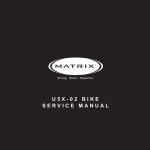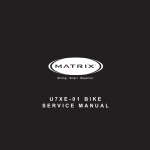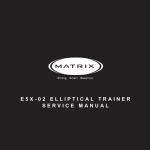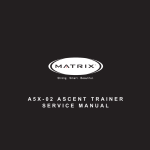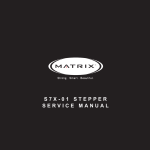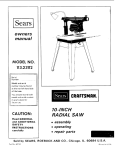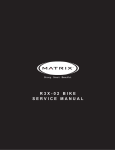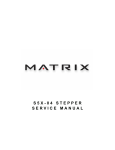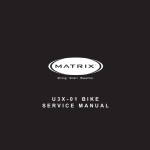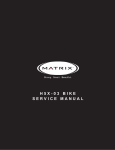Download Matrix h5x-02 Service manual
Transcript
h5x-02 Bike SERVICE MANUAl table of contents CHAPTER 1: Serial number location . .................................................................. 1 CHAPTER 2: Important Safety instructions 2.1 2.2 Read and Save These Instructions . .......................................................................... 3 Electrical Requirements ............................................................................................. 4 CHAPTER 3: Preventative Maintenance 3.1 3.2 3.3 Recommended Cleaning Tips . .................................................................................. 5 Check for Damaged Parts ......................................................................................... 5 Care and Maintenance Instructions ........................................................................... 6 CHAPTER 4: CONSOLE OVERLAY AND WORKOUT DESCRIPTION 4.1 4.2 4.3 4.4 4.5 4.6 4.7 Console Description ................................................................................................... Workout Setup Steps - Manual................................................................................... Workout Setup Steps - Fat Burn................................................................................. Workout Setup Steps - Level Based........................................................................... Workout Setup Steps - Fitness Test............................................................................ Workout Setup Steps - Target Heart Rate.................................................................. Workout Setup Steps - Constant Watts...................................................................... 7 8 8 8 9 10 11 CHAPTER 5: Manager MODE 5.1 5.2 Using Manager Mode ................................................................................................ 12 Manager Mode Overview............................................................................................ 13 CHAPTER 6: ENGINEERING / SERVICE MODE 6.1 Engineering / Service Mode Overview........................................................................ 14 CHAPTER 7: TROUBLESHOOTING 7.1 7.2 7.3 7.4 7.5 7.6 7.7 7.8 7.9 7.10 Electrical Diagrams .................................................................................................... Error Codes on the Console....................................................................................... LCB LED Indicators.................................................................................................... Troubleshooting - Display Issues................................................................................ Troubleshooting - Error 0x04A0.................................................................................. Troubleshooting - Keypad Issues................................................................................ Troubleshooting - Resistance Issues.......................................................................... Troubleshooting - Pedals Slipping.............................................................................. Troubleshooting - Noise Issues................................................................................... Troubleshooting - Heart Rate Issues.......................................................................... 15 17 18 19 20 21 22 23 24 24 CHAPTER 8: PART REPLACEMENT GUIDE 8.1 8.2 8.3 8.4 8.5 8.6 Console Replacement................................................................................................. Heart Rate Handlebar Replacement . ........................................................................ Heart Rate Grip Replacement ................................................................................... Cup Holder Replacement............................................................................................ Console Keypad / Overlay Replacement.................................................................... Console Mast Removal............................................................................................... 25 26 27 28 29 32 i table of contents 8.7 8.8 8.9 8.10 8.11 8.12 8.13 8.14 8.15 8.16 8.17 8.18 8.19 8.20 8.21 Seat Pad Replacement............................................................................................... 33 Back Pad Replacement.............................................................................................. 34 Stationary Handlebar Replacement............................................................................ 35 Pedals Replacement .................................................................................................. 36 Rear Shroud Replacement......................................................................................... 37 Front Shroud Replacement......................................................................................... 38 Lower Control Board Replacement . .......................................................................... 39 Drive Belt Replacement ............................................................................................. 40 ECB (Electronic Brake) Belt Replacement................................................................. 41 ECB (Electronic Brake) Replacement......................................................................... 42 Pulley Axle Set Replacement.......................................................................................... 43 Crank Axle Set Replacement ......................................................................................... 45 Rear Stabilizer Replacement........................................................................................... 46 Front Stabilizer Replacement.......................................................................................... 47 Testing the Bike................................................................................................................ 48 CHAPTER 9: Bike specifications and assembly guide 9.1 9.2 9.3 9.4 9.5 ii iv H5x-02 Bike Specifications......................................................................................... Fasteners and Assembly Tools................................................................................... Assembly Instructions ................................................................................................ Adjusting the Pedal Straps and Seat.......................................................................... Leveling the Bike......................................................................................................... 49 50 51 57 58 Chapter 1: Serial number location 1.1 Serial Number Location A serial number plate is located behind the seat in the seat track. There is also a serial number tag on the middle of the main frame pointed towards the floor. 1 Chapter 1: Serial number location 1.1 SERIAL NUMBER LOCATION - CONTINUED console serial number location 2 Chapter 2: Important Safety Instructions 2.1 Read and Save these instructions To ensure your safety and protect the equipment, read all instructions before operating the MATRIX H5x-02 Bike. To ensure proper use of the Matrix H5x-02 Bike, make sure that all users read this manual. Remind the users that before undertaking any fitness program, they should obtain complete physical examinations from their physicians. If, at any time while exercising, the user experiences dizziness, pain, or shortness of breath, nausea or feels faint, he or she must stop immediately. CAUTION! If you experience chest pains, nausea, dizziness, or shortness of breath, stop exercising immediately and consult your physician before continuing. CAUTION! Any changes or modifications to this equipment could void the product warranty. * This bike is only to be used for its intended purpose described in this manual. Do not use attachments that have not been recommended by Matrix. * Never drop or insert objects into any opening. Keep hands away from moving parts. If the item cannot be reached, contact a Matrix authorized dealer for assistance. * Never operate the unit if it is damaged, not working properly, when it has been dropped, or has been dropped in water. * Keep hands and feet clear at all times from moving parts to avoid injury. * Do not use this product outdoors, near swimming pools or in areas of high humidity. * Do not operate where aerosol (spray) products are being used or when oxygen is being administered. * Do not use this product in bare feet. Do not wear shoes with heels, leather soles, cleats, or spikes while exercising. * Do not remove the side covers. Service should only be done by an authorized service technician. * Close supervision is necessary when used near children, invalids, or disabled people. * When the bike is in use, young children and pets should be kept at least 3 meters / 10 feet away. * Assemble and operate the bike on a solid, level surface. * Never face backward while using the Matrix H5x-02 Bike. * Use the stationary handlebars when mounting or dismounting the bike. * Do not wear clothing that might catch on any moving parts of this bike. 3 Chapter 2: Important safety instructions 2.2 electrical requirements The Matrix H5x-02 Bike is designed to be self powered and does not require an external power supply source to operate. However, this bike can be AC powered if an optional power cord is purchased. This will power the console at all times and requires no minimum RPM for operation. These units can be daisy chained together, up to 4 units per dedicated 15 amp circuit, using a Matrix daisy chain cord adapter (sold separately). For your safety and for the performance of your Matrix bike, the ground on your circuits must be non looped. Please refer to NEC articles 210-21 and 210-23. Any alterations to the standard Matrix power cords will void all warranties. GROUNDING INSTRUCTIONS: The Matrix H5x-02 Bike must be grounded. If it should malfunction or break down, grounding provides a path of least resistance for electric current to reduce the risk of electric shock. The bike is equipped with a cord having an equipment grounding conductor and a grounding plug. The plug must be plugged into an appropriate outlet that is properly installed and grounded in accordance with all local codes and ordinances. If the user does not follow these grounding instructions, the user could void the Matrix limited warranty. DANGER: Improper connection of the equipment grounding conductor can result in the risk of electric shock. Check with a qualified electrician if the user is in doubt as to whether the product is properly grounded. Do not modify the plug provided with the product if it will not fit the outlet, have a proper outlet installed by an electrician 4 Chapter 3: PREVENTATIVE MAINTENANCE 3.1 recommended cleaning tips 3.2 Check for damaged parts Preventative maintenance and daily cleaning will prolong the life and look of your MATRIX H5x-02 Bike DO NOT use any equipment that is damaged or has worn or broken parts. Use only replacement parts supplied by Matrix Fitness Systems. Please read and follow these tips. *Position the equipment away from direct sunlight. The intense UV light can cause discoloration on plastics. *Locate your equipment in an area with cool temperatures and low humidity. * Clean with a soft 100% cotton cloth. *Clean with soap and water or other non-ammonia based all purpose cleaners. *Wipe seats, pedals, console, heart rate grips, and the handlebar clean after each use. MAINTAIN LABELS AND NAMEPLATES. Do not remove labels for any reason. They contain important information. If unreadable or missing, contact Matrix Fitness Systems for a replacement at 866-693-4863 or www.matrixfitness.com. MAINTAIN ALL EQUIPMENT. Preventative maintenance is the key to smoothly operating equipment. Equipment needs to be inspected at regular intervals. Defective components must be kept out of use until they are repaired. Ensure that any person(s) making adjustments or performing maintenance or repair of any kind is qualified to do so. Matrix Fitness Systems will provide service and maintenance training at our corporate facility upon request or in the field if proper arrangements are made. *Do not pour liquids directly onto your equipment. This can cause damage to the equipment and in some cases electrocution. * Check pedal straps weekly for wear. * Adjust leveling feet when equipment wobbles or rocks. * Maintain a clean area around the equipment, free from dust and dirt. 5 Chapter 3: PREVENTATIVE MAINTENANCE 3.3 Care and maintenance instructions In order to maximize life span, and minimize down time, all MATRIX equipment requires regular cleaning, and maintenance items performed on a scheduled basis. This section contains detailed instructions on how to perform these items and the frequency of which they should be done. Some basic tools and supplies will be necessary to perform these tasks which include (but may not be limited to): * Metric Allen wrenches * #2 Phillips head screwdriver * Adjustable wrench * Torque wrench (capability to read foot lbs and inch lbs) * Lint free cleaning cloths * Teflon based spray lubricant such as "Super Lube" or other Matrix approved products. * Mild water soluable detergent such as "Simple Green" or other Matrix approved products * Vacuum cleaner with an extendable hose and crevasse tool attachment. You may periodically see addendums to this document, as the Matrix Technical Support Team identifies items that require specific attention, the latest version will always be available on the Matrix web site at www.matrixfitness.com. DAILY MAINTENANCE ITEMS 1) Look and listen for loose fasteners, unusual noises, and any other indications that the equipment may be in need of service. 2) Clean the bike before and after each use, including: a. Use a damp, soft cloth with water or mild liquid detergent to clean all exposed surfaces. DO NOT use ammonia, chlorine, or any acid based cleaners. b. Keep the console display free of fingerprints and salt build up caused by sweat. WEEKLY MAINTENANCE ITEMS 1) Frequently vacuum the floor beneath the unit to prevent the accumulation of dust and dirt which can affect the smooth operation of the unit. 2) Check the pedal straps for damage. 3) Clean the grooves on the foot pedals. MONTHLY MAINTENANCE ITEMS 1) Inspect the console, seat, pedals, and shrouds for damage. 2) Tighten the pedals onto their respective cranks using a 15 mm wrench. 3) Adjust the leveling feet if equipment rocks or wobbles. QuARTERLY MAINTENANCE ITEMS 1) Remove the front shrouds and check the belt for damage, alignment, and proper tension. 6 Chapter 4: Console Overlay and workout description 4.1 Console Description WORKOUT KEYS: Simple program view and selection buttons. GO: One touch Start. UP / DOWN LEVEL: Easy information and level selection. UP / DOWN TIME: Easy information and time adjustment. STOP: Ends workout and shows workout summary data. NUMBER KEYPAD: Workout data input for workout setup. Level adjustment during workout. COOL DOWN: Puts bike into Cool Down mode. FAN: Allows for fan speed selection (fan has 3 operating speeds). TOGGLE DISPLAY: Allows user to select what information is displayed on the console. 7 Chapter 4: Console overlay and workout description 4.2 workout setup steps - manual 4.4 workout setup steps - level based GO - Press to immediately begin a workout. Workout, resistance ROLLING HILLS - The Rolling Hills program is a level based 1) Start pedaling and press the GO key to begin your workout. 2) The display will read 3, 2, 1, Begin and then the program will start. 1) Start pedaling and press the ROLLING HILLS key. 2) Select Level by using the UP or DOWN LEVEL keys and press ENTER. 3) Select Time by using the UP or DOWN LEVEL keys and press ENTER. 4) Select Weight by using the UP or DOWN LEVEL keys and press ENTER. 5) The display will read 3, 2, 1, Begin and then the program will start. level, and time will automatically go to default settings. Pressing GO will not prompt user for age, weight, or level settings. MANUAL - Manual allows the user to input more information while defining their own workout. Calorie expenditure will be more accurate when inputting information in Manual than by pressing GO. 1) Start pedaling, press the MANUAL key. 2) Select Level by using the UP or DOWN LEVEL keys and press ENTER. 3) Select Time by using the UP or DOWN LEVEL keys and press ENTER. 4) Select Weight by using the UP or DOWN LEVEL keys and press ENTER. 5) The display will read 3, 2, 1, Begin and then the program will start. 4.3 workout setup steps - fat burn FAT BURN - Fat burn is a level based program that is designed program that automatically adjusts the resistance level to simulate real terrain. INTERVAL TRAINING - The Interval Training program is a level based program that automatically adjusts the resistance of the machine from low to high intensity settings at regular intervals. 1) Start pedaling and press the INTERVAL TRAINING key. 2) Select Level by using the UP or DOWN LEVEL keys and press ENTER. 3) Select Time by using the UP or DOWN LEVEL keys and press ENTER. 4) Select Weight by using the UP or DOWN LEVEL keys and press ENTER. 5) The display will read 3, 2, 1, Begin and then the program will start. to help users burn fat through various resistance level changes. 1) Start pedaling and press the FAT BURN key. 2) Select Level by using the UP or DOWN LEVEL keys and press ENTER. 3) Select Time by using the UP or DOWN LEVEL keys and press ENTER. 4) Select Weight by using the UP or DOWN LEVEL keys and press ENTER. 5) The display will read 3, 2, 1, Begin and then the program will start. 8 RANDOM - Random is a level based workout that randomly adjusts the resistance of the machine. 1) Start pedaling and press the key next to RANDOM key. 2) Select Level by using the UP or DOWN LEVEL keys and press ENTER. 3) Select Time by using the UP or DOWN LEVEL keys and press ENTER. 4) Select Weight by using the UP or DOWN LEVEL keys and press ENTER. 5) The display will read 3, 2, 1, Begin and then the program will start. Chapter 4: Console overlay and workout description 4.5 WORKOUT SETUP STEPS - Fitness test FITNESS TEST -The Cooper Fitness Test measures cardiovascular fitness and proves an estimated sub-maximal VO2 result. It is based on power output according to ACSM standards and was developed by the Cooper Institute© (www.cooperinstitute.org). User RPMs must remain between 60-80 RPM during the test. The test will end when the user can no longer maintain this speed. Use of a heart rate strap is optional but provides more data. The test starts at a low intensity level and gradually increases in intensity (difficutly) every 2 minutes. As it increases, the user must maintain 60-80 RPM to advance to the next level. The test could take upwards of 30+ minutes for very fit individuals. Once the test ends a recovery period (cool down) will begin and the user's results are calculated and displayed. Results are based on the number of stages completed. Incline will not be adjustable during the test. 1) 2) 3) 4) 5) 6) Start pedaling and press the FITNESS TEST key. Select Age by using the UP or DOWN LEVEL keys and press ENTER. Select Gender by using the UP or DOWN LEVEL keys and press ENTER. Select Weight by using the UP or DOWN LEVEL keys and press ENTER. The display will read 3, 2, 1, Begin and then the program will start. Once the workout is complete, the display will read the results of the Fitness Test. STAGES COMPLETED: 1 2 3 4 5 6 7 8 9+ Well Below Average Well Below Average Below Average Below Average Average Average Above Average Above Average Well Above Average 9 Chapter 4: Console overlay and workout description 4.6 Workout Setup steps - TARGET heart rate TARGET HEART RATE - The Matrix H5x-02 Bike comes with standard digital contact heart rate sensors and are POLAR telemetry compatible. The heart rate control workout mode allows the user to program their desired heart rate zone, and the bike will automatically adjust the level based upon the user's heart rate. The heart rate zone is calculated using the following equation: (220-Age)8%=target heart rate zone. The user must wear a POLAR telemetric strap or continually hold onto the contact heart rate grips for this workout. Locate the metal sensors on the handlebars of the bike. Notice that there are two separate pieces of metal on each grip. You must be making contact with both pieces of each grip to get an accurate heart rate reading. You can grab these sensors in any program to view your current heart rate. 1) Start pedaling and press the HEART RATE key. 2) Select Age by using the UP or DOWN LEVEL keys and press SELECT. 3) Select Target HR Percentage by using the UP or DOWN LEVEL keys and press SELECT. 4) Select Time by using the UP or DOWN LEVEL keys and press SELECT. 5) Select Weight by using the UP or DOWN LEVEL keys and press SELECT. 6) The display will read 3, 2, 1, Begin and the program will start. 10 4.7 workout setup steps - CONSTANT watts CONSTANT WATTS - Constant Watts is a unique program that allows you to vary your cadence or RPM and the bike's resistance level will adjust accordingly to your selected goal. The quicker you pedal, the less resistance for the goal selected. 1) Start pedaling and press the CONSTANT WATTS key. 2) Select Watts by using the UP or DOWN LEVEL keys and press SELECT. 3) Select Time by using the UP or DOWN LEVEL keys and press SELECT. 4) Select Weight by using the UP or DOWN LEVEL keys and press SELECT. 5) The display will read 3, 2, 1, Begin and the program will start. Chapter 5: MANAGER MODE 5.1 Using Manager Mode The Manager's Custom Mode allows the club owner to customize the bike for the club. 1) To enter Manager Mode, press and hold down the UP and DOWN LEVEL keys. Continue to hold down these two keys until the display reads Manager Mode and hit ENTER (Figure A). 2) To scroll through the list of options in Manager Mode, use the UP and DOWN LEVEL keys. Each of the custom settings will show on the display. 3) To select a custom setting, press the ENTER key when the desired setting is shown. 4) To change the value of the setting, use the UP and DOWN LEVEL keys. 5) To confirm and save the value of the setting, press the ENTER key. 6) To exit the setting without saving, press the BACK key. 7) Press and hold the HOME key for 3-5 seconds to return to normal operation. 11 Chapter 5: MANAGER MODE 5.2 Manager mode overview 12 CUSTOM SETTING DEFAULT MINIMUM MAXIMUM Description Maximum Time 95 min 10 min 95 min Sets the total run time of any program. Default Time 20 min 10 min Maximum Time Setting Workout time when GO is pressed or when no time is selected during program set up. Default Level 1 1 20 Starting resistance when GO is pressed or when no resistance is selected during program set up. Default Age 30 10 100 Starting age when GO is pressed or when no age is selected during program set up. Default User Weight 150 lbs / 75 kg 80 lbs / 36 kg 400 lbs / 181 kg Weight used for program calorie expenditure calculations. Accumulated Distance N/A 0 65,000 Miles Total distance for all programs. Accumulated Time N/A 0 65,000 hours Total time for all programs displayed in hours. Software Version N/A N/A N/A Current version of console software. Timer Mode Up Up Down Determines whether the timer counts up or down. Speed / Distance Mode Mile Mile Kilometer Displays distance in miles or kilometers. Out of Order No No Yes Locks the machine when out of order. Gender Male Male Female Determines the gender of the user when not selected during program set up. Language English English English Sets the language for the console. Select between English, Spanish, German, French, Italian, and Dutch. Sound Mode On Off Speaker Turns the chime on / off when a button is pressed. chapter 6: engineering / service mode 6.1 engineering / service mode overview To enter Engineering or Service Mode, hold the UP and DOWN LEVEL keys for 3 seconds until Manager Mode appears on the middle LED display. Press the UP or DOWN LEVEL key to scroll between the different Engineering (Figure A) and Service Modes (Figure B). ENGINEERING MODE DISABLE ERRORS: Displays the class A and B error codes. SPEED UNIT: Sets the distance to show in miles or kilometers. MACHINE TYPE: Should be set for Bike at all times. POWER SAVE TIME: Sets the amount of time the console keeps the workout information after the completion of a workout. SERVICE MODE SERVICE 1: Display Test. SERVICE 2: Keypad Test. SERVICE 3: Accumulated Distance and Time. SERVICE 4: CSAFE Test. SERVICE 5: Error Log. 13 Chapter 7: TROUBLESHOOTING 7.1 Electrical Diagrams 14 Chapter 7: Troubleshooting 7.1 Electrical Diagrams 15 Chapter 7: TROUBLESHOOTING 7.1 Electrical Diagrams 16 Chapter 7: Troubleshooting 7.2 error codes on the console code class description solution 0x02AB c Machine type error. Set the correct machine type in Engineering Mode. 0x02B3 c Resistance type error. Set the correct machine type in Engineering Mode. 0x0201 a Low voltage on the battery (voltage under 11.2V). Charge by running or by plugging in the AC adapter. 0x0247 b LCB failed (memory write error / feedback ADC error). Replace the LCB. 0x0248 b Battery failure or disconnection (Voltage under 8V or over 15V). Check the wire connections at the battery. Replace the battery. 0x0441 b When the UCB implements a command, the LCB is not receiving this command. Check the machine type in Engineering Mode. Check the connections at the UCB and LCB. 0x04A0 c Digital Communication Failure. LCB has no return message for the UCB for 3 seconds. Check the console cable connections at the UCB and LCB. Replace the UCB or LCB as needed. 0x04B0 C UCB No Response. Check the console cable connections at the UCB and LCB. Replace the UCB or LCB as needed. CLASS C errors will display on the console. Class A or B errors will only display in Service Mode 5. 17 Chapter 7: Troubleshooting 7.3 LCB LED instructions led indicator description LED 1 RPM (AC Plug In). LED 2 +5V LED 3 +15V LED 4 Bus Voltage LED 5 RPM (Generator). LED 6 Status 1 (Program operation). LED 7 Status 2 (Resistance value in middle 1/2 VCC). LED 8 Status 3 (Digital Communication). LED 9 +12V (Console Power). WITHOUT AC PLUG - Normal LED 2 - LED 9 - On. LED 1 - Off (No AC plug detected). LED 5 - On (Generator power detected), WITH AC PLUG - NORMAL LED 2 - LED 9 - On. LED 1 - On (AC plug detected). LED 5 - Off (No Generator power detected). led 1 led 5 18 Chapter 7: Troubleshooting 7.4 troubleshooting - display issues no display on the console or the display is dim when running led 9 led 1 led 8 led 5 symptom: The console will not power up or the display is dim. check point possible issue solution LEDs 2, 3, 4, 6, and 7 should be ON. If they are OFF, the LCB is damaged. Replace the LCB. if LED1 is OFF. No AC power cord plugged in. Normal for an unpowered unit. if LED 5 is OFF. Generator has no RPM output. Normal for a powered unit. If unpowered and issue is still present, replace the generator. if LED 8 is OFF. Bad communication between UCB and LCB. Reconnect the console cable at the LCB and UCB and check for kinks. if LED 9 is OFF. LCB is not providing 12V power to the UCB. Replace the LCB. solution if LEDs are normal: 1) If the LEDs are lit normally, replace the UCB and console cable. 2) if the issue is still present after the UCB and console cable are replaced, replace the LCB. 19 Chapter 7: Troubleshooting 7.5 troubleshooting - error 0x04A0 error 0x04A0 (Digital communication failure) led 1 led 8 symptom: Error code 0x04A0 is displayed on the console. check point possible issue solution LEDs 2, 3, 4, 6, 7 should be ON. If they are OFF, the LCB is damaged. Replace the LCB. if LED1 is OFF. No AC power cord plugged in. Normal for an unpowered unit. if LED 8 is OFF. Bad communication between UCB and LCB. Reconnect the console cable at the LCB and UCB and check for kinks. Solution if leds are normal: 1) If the LEDs are lit normally, replace the UCB and console cable. 2) if the issue is still present after the UCB and console cable are replaced, replace the LCB. 20 Chapter 7: Troubleshooting 7.6 troubleshooting - keypad issues all or some of the function keys do not respond possible causes: 1) The keypad connection ribbon cable has not been plugged in correctly. 2) The keypad is damaged. 3) The UCB is damaged. SOLUTION: 1) Perform a keypad test in Service Mode: a. Press and hold both the UP and DOWN LEVEL keys until Manager Mode appears on the display. b. Use the UP and DOWN LEVEL keys to scroll to Service Mode 5 and press ENTER. c. Test the affected keypad. If the keypad works in the keypad test it may not be a functioning key in the program used for testing it. 2) Check the connections of the keypad at the UCB. a. Remove the console from the console mast. b. Remove the 6 screws holding the back of the console to the front (Figure A). c. Inspect the keypad ribbon cable connection at the UCB (Figure B). d. Even if the keypad ribbon cable appears to be connected correctly, unplug and reseat the cable. 3) Replace the affected keypad. 4) Replace the UCB. figure a figure b 21 Chapter 7: Troubleshooting 7.7 troubleshooting - resistance issues High or no resistance possible causes: 1) 2) 3) 4) The The The The console cable is damaged or not properly plugged in. UCB is damaged. Generator is damaged. LCB is damaged. SOLUTION: 1) Check the console cable connections at the UCB and LCB. 2) Check if the generator is outputing variable power: a. Insert the probes from a multi-meter into the black and red wires on the generator wire harness connector (Figure A). b. When pedaling, the output voltage from the generator should vary depending on the RPM. The generator should output 120 VAC at 94 RPM. 3) If the generator does not have variable power, replace the generator. 4) If the generator does have variable power, replace the LCB. figure a 22 Chapter 7: Troubleshooting 7.8 troubleshooting - pedals slipping pedals slipping Possible causes: 1) The belt tension is not enough. 2) The one way bearing is damaged. SOLUTION: 1) Remove the covers and check the belt tension. a. Tighten the drive belt tension if needed by moving the spring tension clip to another hole. b. The ECB belt should be tightened to 85 ft / lbs. 2) If the belts are tensioned correctly, the one way bearing is damaged, replace the drive assembly. 7.9 troubleshooting - noise issues Knocking or creaking noise Possible causes: 1) The pedal is on the crank too loosely. 2) The crank or axle is worn out. 3) The belt tension is not enough, or the belts are too dirty. SOLUTION: 1) Retighten the pedal on the crank. 2) Replace the crank or axle as needed. 3) Remove the covers and check the belt tension. a. Tighten the drive belt tension if needed by moving the spring tension clip to another hole. b. The ECB belt should be tightened to 85 ft / lbs. 4) Clean the belts. If they are worn or will not clean, replace the belts. 23 Chapter 7: Troubleshooting 7.10 troubleshooting - heart rate issues heart rate function does not work or is reading incorrectly possible causes: 1) 2) 3) 4) 5) 6) The The The The The The chest strap being used is not making good contact with the user's chest. chest strap is at a low battery status. chest strap is damaged. HR grips are damaged. HR board is damaged. UCB is damaged. SOLUTION: 1) Recenter the chest strap below the user's pectoral muscle (Figure A) and check again. 2) Replace the battery in the chest strap. 3) Replace the chest strap. 4) If there is no HR present, replace the HR grips. 5) If there is a HR present but it is much higher than normal, replace the HR board. 6) If replacing the HR grips and board does not resolve the issues, replace the console. figure a 24 chapter 8: part replacement guide 8.1 CONSOLE REPLACEMENT 1) Remove the 4 screws holding the console to the frame (Figure A). Figure A 2) Disconnect the console cable and HR connections from the defective console and remove the console (Figure B). Figure B 3) Reinstall the wire connections to the new console. 4) Carefully push the wires into the console and mast until they are clear of the console / mast connection and attach the console to the mast using the 4 screws. 5) Test the bike for function as outlined in Section 8.21. 25 Chapter 8: Part Replacement Guide 8.2 HEART RATE HANDLEBAR REPLACEMENT 1) Remove the 2 screws holding on the handlebar cover (Figures A & B). Figure A Figure B 2) Remove the 4 screws holding the heart rate handlebar to the console mast being careful to support the handlebar (Figure C). 3) Carefully pull the wires from the console mast until the connectors are showing, and then disconnect the 3 wires from the handlebar and remove the defective handlebar (Figure D). Figure c 4) Reverse Steps 1-3 to install a new handlebar. 5) Test the bike for function as outlined in Section 8.21. 26 figure d Chapter 8: Part Replacement Guide 8.3 HEART RATE GRIPS REPLACEMENT 1) Using a flat screwdriver, pry the silver metal heart rate plate on the back side of the HR grip away from the plastic of the HR grip (Figure A). 2) Disconnect the HR grip wire and remove the metal plate (Figure B). Figure A Figure B 3) Remove the 3 screws holding the HR grip together (Figure C). 4) Disconnect the level button and remove the two halves of the HR grip (Figure D). Figure C Figure D 5) Reverse Steps 1-4 to install new HR grips. 6) Test the Bike for function as outlined in Section 8.21. 27 Chapter 8: Part Replacement Guide 8.4 CUP HOLDER REPLACEMENT 1) Remove the 2 screws holding the cup holder to the console mast (Figure A). Figure A 2) Remove the cup holder (Figure B). Figure B 3) Reverse Steps 1-2 to install a new cup holder. 28 Chapter 8: Part Replacement Guide 8.5 CONSOLE KEYPAD / OVERLAY REPLACEMENT 1) Remove the console as outlined in Section 8.1. 2) Remove the back cover of the console (Figure A). 3) Unplug and remove the faulty overlay (Figure B). Figure A Figure B 4) Clean the console area with alcohol to remove any left over adhesive (Figure C). 5) Remove the protective film over the display window of the overlay (Figure D). Figure C Figure D 29 Chapter 8: Part Replacement Guide 8.5 CONSOLE KEYPAD / OVERLAY REPLACEMENT - CONTINUED 6) Peel part of the protective film from the back of the overlay (Figure E). 7) Push the overlay ribbon cable through the hole in the console and plug it in (Figure F). Figure E Figure F 8) Match the overlay to the cutout on the console (Figure G). Figure G 30 Chapter 8: Part Replacement Guide 8.5 CONSOLE KEYPAD / OVERLAY REPLACEMENT - CONTINUED 9) Press down on the corners of the overlay to keep it in place, then remove the protective film (Figure H & I). Figure H figure i 10) Once the overlay is in the correct position, press down on the overlay with a cloth to adhere it to the console plastic (Figure J). figure j 11) Use the same procedure to replace any additional faulty overlays. NOTE: Overlays can not be reused. 12) Test the Bike for function as outlined in Section 8.21. 31 Chapter 8: Part Replacement Guide 8.6 console mast rePLACEMENT 1) Remove the console as outlined in Section 8.1. 2) Remove the HR handlebars as outlined in Section 8.2. 3) Lift up the rubber boot at the bottom of the console mast (Figure A). Figure A 4) With the boot lifted, remove the 4 screws holding the console mast to the frame (Figure B). Figure B 5) Pull the wires out the bottom of the console mast and remove the mast. 6) Reverse Steps 1-5 to install a new console mast. NOTE: When installing a new console mast, be sure to pull the console wires up through the new mast prior to installing the 4 screws into the frame. 7) Test the bike for function as outlined in Section 8.21. 32 Chapter 8: Part Replacement Guide 8.7 seat pad replacement 1) Remove the 4 screws holding the seat pad to the seat post (Figure A). Figure A 2) Lift the seat pad away from the seat post (Figure B). Figure B 3) Reverse Steps 1-2 to install a new seat pad. 33 Chapter 8: Part Replacement Guide 8.8 back pad Replacement 1) Using the tips of your fingers, remove the back cover of the back pad. The back cover is held on by plastic snap clips, and if pressure is applied, the cover will pop off (Figure A). 2) Remove the 4 bolts holding the seat pad to the seat frame (Figure B). Figure A Figure B 3) Remove the back pad (Figure C). Figure C 4) Reverse Steps 1-3 to install a new back pad. 34 Chapter 8: Part Replacement Guide 8.9 stationary handlebar Replacement 1) Using the tips of your fingers, remove the back cover of the back pad. The back cover is held on by plastic snap clips, and if pressure is applied, the cover will pop off (Figure A). 2) Remove the 4 bolts holding the stationary handlebar assembly to the seat frame (Figure B). Figure A Figure B 3) Remove the stationary handlebar (Figure C). Figure C 4) Reverse Steps 1-3 to install a new stationary handlebar. 35 Chapter 8: Part Replacement Guide 8.10 Pedal replacement 1) Use a 15 mm wrench to remove the pedal from the crank (Figure A). NOTE: For the right side pedal, the threads are normal. For the left side pedal, the threads are reversed (the pedal turns off counterclockwise). Figure A 2) Remove the pedal (Figure B). Figure B 3) Reverse Steps 1-2 to install a new pedal. 36 Chapter 8: Part Replacement Guide 8.11 Rear Shroud replacement 1) Remove the 9 screws attaching the right side rear shroud to the frame and to the left shroud (Figure A). 2) Remove the 3 screws attaching the left side rear shroud to the frame (Figure B). figure a figure b 3) Figure C shows both the rear shrouds removed. figure c 4) Reverse Steps 1-2 to install new rear shrouds. 37 Chapter 8: Part Replacement Guide 8.12 front shroud replacement 1) Remove the pedals as outlined in Section 8.10. 2) Remove the 8 screws attaching the right side front shroud to the frame and to the left shroud (Figure A). 3) Remove the 5 screws attaching the left side front shroud to the frame and entertainment port (Figure B). figure a figure b 4) Figure C shows both the front shrouds removed. figure c 5) Reverse Steps 1-3 to install a new front shroud. 38 Chapter 8: Part Replacement Guide 8.13 LOWER CONTROL BOARD REPLACEMENT 1) Remove the rear shrouds as outlined in Section 8.11. 2) Disconnect the wire connections to the lower board (Figure A). figure a 3) Remove the 2 screws holding the lower board to the frame (Figure B), and remove the lower board. figure b 4) Reverse Steps 1-3 to install a new lower board. 5) Test the bike for function as outlined in Section 8.21. 39 Chapter 8: Part Replacement Guide 8.14 DRIVE BELT REPLACEMENT 1) Remove the right side front shroud as outlined in Section 8.12. 2) Unattach the tension set spring from the frame (Figure A). fIGURE a 3) Rotate the tension set counter clockwise and remove the drive belt (Figure B). fIGURE b 4) Reverse Steps 1-3 to install a new drive belt. NOTE: Be sure to reattach the tension spring. If more tension is needed on the drive belt, multiple holes are available for the lower spring attachment. 5) Test the bike for function as outlined in Section 8.21. 40 Chapter 8: Part Replacement Guide 8.15 ECB (ELECTRONIC BRAKE) BELT REPLACEMENT 1) Remove the front shrouds as outlined in Section 8.12. 2) Loosen the nuts holding the ECB to the frame (Figure A), and remove the nuts putting tension on the ECB belt (Figure B). fiGURE a fIgure b 3) Once the tension has been removed, the ECB belt can be walked off of the pulley (Figure C). 4) Pull the ECB out of the frame towards the front of the unit, and remove the ECB belt (Figure D). figure c figure d 5) Reverse Steps 1-4 to install a new ECB belt. NOTE: Be sure to retension the new ECB belt to 85 ft / lbs. 6) Test the bike for function as outlined in Section 8.21. 41 Chapter 8: part replacement guide 8.16 ECB replacement 1) Remove the front shrouds as outlined in Section 8.12. 2) Remove the nuts holding the ECB to the frame (Figure A), and remove the nuts putting tension on the ECB belt (Figure B). figure a figure b 3) Once the tension has been removed, the ECB belt can be walked off of the pulley (Figure C). 4) Pull the ECB out of the frame towards the front of the unit, and remove the ECB belt (Figure D). figure c 5) Reverse Steps 1-4 to install a new ECB. 6) Test the bike for function as outlined in Section 8.21. 42 figure d Chapter 8: part replacement guide 8.17 pulley axle set replacement 1) Remove the front shrouds as outlined in Section 8.12. 2) Remove the drive belt as outlined in Section 8.14. 3) Loosen the nuts holding the ECB to the frame (Figure A), and remove the nuts putting tension on the ECB belt (Figure B). figure a figure b 4) Once the tension has been removed, walk the ECB belt off of the pulley (Figure C). figure c 43 Chapter 8: part replacement guide 8.17 pulley axle set Replacement - continued 5) Remove the C-clip holding the bearing in place on the right side of the frame (Figure D). 6) Remove the bearing (Figure E). fIGURE D Figure E 7) Remove the large nut holding in the pulley axle assembly with a large channel lock pliers or a pipe wrench (Figure F). 8) Once the large nut is removed, the pulley axle set can be hammered out of the frame (Figure G), it should be removed from the user's left side. Figure F 9) Reverse Steps 1-8 to install a new pulley axle set. 10) Test the bike for function as outlined in Section 8.21. 44 FIgure G Chapter 8: Part Replacement Guide 8.18 crank axle set replacement 1) 2) 3) 4) Remove the front shrouds as outlined in Section 8.12. Remove the drive belt as outlined in Section 8.14. Remove the 3 screws holding the crank axle bearings in place on both sides (Figure A). Bend the tabs of the nut on the left side of the frame so that this nut will turn (Figure B). Figure A Figure B 5) Use a 32 mm wrench to remove the crank axle nuts (Figure C). NOTE: This nut is reverse threaded. figure c 6) Once the nuts are removed, the crank axle can be removed from the frame from the right side. 7) Reverse Steps 1-6 to install a new crank axle set. 8) Test the bike as outlined in Section 8.21. 45 Chapter 8: Part Replacement Guide 8.19 rear stabilizer replacement 1) Lean the bike to one side and remove the 4 screws holding the rear stabilizer to the frame (Figure A). Figure A 2) Remove the rear stabilizer (Figure B). Figure B 3) Reverse Steps 1-2 to install a rear stabilizer. 46 Chapter 8: Part Replacement Guide 8.20 Front stabilizer replacement 1) Lean the bike to one side and remove the 4 screws holding the front stabilizer to the frame (Figure A). Figure A 2) Remove the front stabilizer (Figure B). Figure B 3) Reverse Steps 1-2 to install a new front stabilizer. 47 Chapter 8: Part Replacement Guide 8.21 Testing the BIKE Once the unit or replacement part is fully installed and assembled and properly placed on the floor, use the following instructions to setup and test the machine: 1) Check that the console is set for bike. a. Press and hold both LEVEL keys until Manager Mode appears on the display. b. Press the UP or DOWN LEVEL keys until Engineering Mode appears on the display. c. Use the UP or DOWN LEVEL keys to scroll to Machine Type. d. Press ENTER on Machine Type and make sure it is set for BIKE. e. If Machine Type is not set for BIKE, change to BIKE using the UP or DOWN LEVEL key and press ENTER to save. f. Press and hold the STOP key for 3-5 seconds to return to normal function. 2) Without hitting start or entering any program modes, sit on the bike and hold the handlebars while pedaling to simulate exercising. While moving, listen for any odd noises or squeaks. 3) After stopping movement, press the green GO key and begin pedaling. 4) Grasp the hand grips to check for proper heart rate response. 5) Press the level up and down buttons on the console and hand grips to make sure resistance is fully functional. 6) If everything functions properly, stop pedaling and the unit will reset to normal operation within 30 seconds. 48 Chapter 9: bike Specifications and Assembly Guide 9.1 H5x-02 BIKE SPECIFICATIONS console Display Type Dot-Matrix LED Display Feedback Time, Distance, Calories, Speed, Heart Rate, METs, Watts, Level, RPM Programs Manual, Rolling, Intervals, Fat Burn, Random, Fitness Test, Target HR, Constant Watts Resistance Levels 25 CSafe, FitLinxx Ready Yes Wireless Data Transmitter Yes iPod Compatible No Nike + iPod Compatible No Personal Fan Yes Technical data Resistance Technology JID Brushless Generator Power Requirements0 Self Powered or Optional 120V / 60Hz AC Minimum Watts 12 Overall Dimensions (L x W x H) 58" x 29" x 59" / 147.3 x 73.7 x 149.9 cm Maximum User Weight 400 lbs / 181.4 kg Unit Weight 172 lbs / 78 kg Shipping Weight 199 lbs / 90.3 kg Transport Wheel Yes USER DATA Contact Heart Rate Sensors Yes Telemetric Heart Rate Receiver Yes Handle Bar Design Front vertical ergo bend Thumb Switch Controls Yes 49 Chapter 9: bike Specifications and assembly guide 9.2 Fasteners and Assembly Tools 50 quantity part # 1 z05 1 z04 1 z01 1 z03 1 sketch description notes 4 mm allen wrench purple See sketch of part Z04 5mm allen wrench purple See sketch of part Z04 6 mm allen wrench purple open end wrench (15 & 17mm) purple z02 #2 phillips screwdriver purple 4 Z11 hex head screw (M8 x 25L) white 4 Z12 spring washer white 2 Z13 button head screw (m5 x 10L) white 8 Z21 Hex head screw (M8 x 20l) black 8 Z22 flat washer black 8 z23 spring washer black 4 z31 button head screw (M8 x 15L) yellow 4 z32 See sketch of part Z22 flat washer yellow 4 z33 See sketch of part Z12 spring washer yellow 2 z34 See sketch of part Z11 hex head screw (M8 x 25L) yellow 4 Z41 See sketch of part Z11 hex head screw (M8 x 50l) red 4 Z42 arc washer red 4 Z43 See sketch of part Z12 spring washer red 4 Z51 See sketch of part Z11 hex head screw (m5 x 15l) green 4 Z52 See sketch of part Z22 flat washer green 4 z53 See sketch of part z12 spring washer green 1 z71 See sketch of part Z12 adjustment foot Chapter 9: bike SPECIFICATIONS AND ASSEMBLY GUIDE 9.3 ASSEMBLY INSTRUCTIONS after these assembly steps are complete, be sure to setup and test the unit as outlined in section 8.20. step 1 51 Chapter 9: bike SPECIFICATIONS AND ASSEMBLY GUIDE 9.3 ASSEMBLY INSTRUCTIONS - CONTINUED step 2 52 Chapter 9: bike SPECIFICATIONS AND ASSEMBLY GUIDE 9.3 Assembly Instructions - Continued step 3 53 Chapter 9: bike SPECIFICATIONS AND ASSEMBLY GUIDE 9.3 ASSEMBLY INSTRUCTIONS - CONTINUED step 4 54 Chapter 9: bike specifications and assembly guide 9.3 ASSEMBLY INSTRUCTIONS - CONTINUED Step 5 55 Chapter 9: bike SPECIFICATIONS AND ASSEMBLY GUIDE 9.3 assembly instructions - continued Step 6 56 Chapter 9: Bike specifications and assembly guide 9.4 Adjusting the pedal straps and SEAT Adjusting the pedal straps The straps are designed to fit your individual foot size and should be adjusted tight enough to keep your foot from slipping. The pedals include spring loaded clips for easy adjustment. To tighten the strap, pull down the open end of the strap. To loosen the strap, push down on the top of the clip and pull the strap up. Release the clip to lock the strap in place. 57 Chapter 9: bike specifications and assembly guide 9.5 LEVELING THE BIKE STABILIZING the MATRIX H5x-02 BIKE After positioning the bike in its intended location, check its stability by attempting to shake it side to side. Shaking or wobbling indicates that your bike needs to be leveled. Determine which leveler is not resting completely on the floor. Loosen the nut with one hand to allow the leveler to rotate. Rotate the left or right leveler, and repeat the adjustment as necessary until the bike is stable. Lock the adjustment by tightening the nut against the rear foot support. 58 NOTES 59 M ATr i x F i tne ss s y st e ms c o rp. 1610 Landmark Drive C ottage G rove wi 5 3 5 2 7 U S A TO LL FREE 866. 693. 4863 w w w. m a t r i x f i t n e s s . c o m KO REV. 1 60 FA X 6 0 8 . 8 3 9 . 1 7 1 7

































































